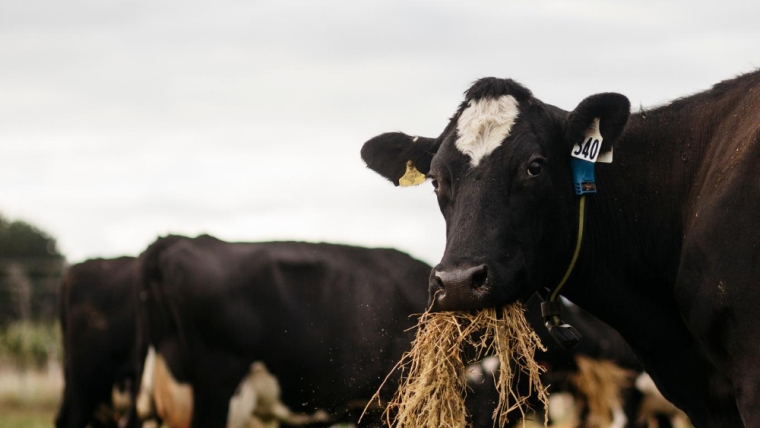
Dairy cooperative Fonterra will attempt to reduce the amount of greenhouse gases emitted by its farmers by 30% per tonne of milk produced by 2030, relative to 2018 levels.
Chief executive Miles Hurrell made the announcement at the cooperative’s annual meeting in Canterbury on Thursday.
He said local farmers needed to maintain their status as some of the most emission-efficient dairy producers in the world.
“There is a lot of activity to reduce emissions across other markets, and the co-op needs to keep making progress to make sure it doesn’t fall behind,” he said.
Over 85% of Fonterra’s emissions come from farms, rather than processing plants. The new target will attempt to reduce the emissions intensity by tonne of milk collected by Fonterra.
Hurrell said lowering the amount of greenhouse gasses emitted per tonne would help to future proof the cooperative for “generations to come”.
Fonterra plans to achieve the 30% reduction through four different categories: new technology, improved farming practices, carbon sinks, and land-use accounting.
The plan relies on a 7% emissions reduction from new methane reduction technologies, such as a special feedstock made from seaweed, a vaccine, and possibly probiotic bacteria supplements. (There's more on the technology here).
Researchers are also exploring ways to remove methane from the air, once emitted.
A joint-venture between the industry and Government has committed $170 million over four years to develop and commercialise methane reduction solutions.
Another 7% reduction will come from helping farmers maximise efficiency through optimising fertiliser use, breeding better and healthier cows, and using higher quality feedstock.
Planting more trees and foliage on steep hills or the margins of paddocks will help lower emissions intensity by another 8%.
Fonterra is also currently on the hook for emissions that have occurred because of converting land into dairy farms. A further 8% ‘reduction’ will occur simply because these converted farms will move outside of the 20-year responsibility window.
Chairman Peter McBride said the emissions reduction target would affect each farm differently.
“We are confident that we can make solid progress towards our target by working together and sharing information farmer-to-farmer,” he said in a statement.
“There’s no one solution to reducing on-farm emissions. It will require a combination of sharing best farming practices and technology to reduce emissions – it’s both our biggest opportunity and our biggest challenge”.
Last month, the Reserve Bank warned dairy farmers were facing financial pressures and some could begin to default on their bank loans if current conditions continue. Operating costs have been climbing much faster than commodity prices, leaving many farmers likely to make a net loss this season.
Fonterra has set its milk price forecast at a midpoint of $7.25 per kilogram for the coming dairy season, down from $8.22 last season. The average breakeven price has been estimated to be around $8 per kilogram and analysis by Figured said half of all dairy farms would make a loss at $6.75.
McBride said Fonterra, which is owned by farmers, had “deep empathy” for the challenges they were facing.
“The co-op’s approach will be to work alongside farmers, not against them, as we collectively make progress towards our target, including investing in methane reduction technologies.”
Fonterra said it spent a year talking with farmers about the target and how to achieve it. The methodology may change as science evolves, it said.
9 Comments
Basically we there already, just work with the latest numbers. Numbers now are overstated with 300% and count grass grown. Whoops we accidentally look 200% better.
If low methane is your thing breeding will get you there.
"Cows in the low (LM) CH4 emitters group had lower daily enteric CH4 emissions than cows in the high (HM) CH4 emitters group (on average 346 vs. 439 g/d, respectively), lower CH4 yield (15.5 vs. 20.4 g of CH4/kg of DMI), and CH4 intensity (13.2 vs. 17.0 g of CH4/ kg of energy-corrected milk yield).
...Milk composition, production, and BW were also not different between LM and HM cows."
Microbial composition, rumen fermentation parameters, enteric methane emissions, and lactational performance of phenotypically high and low methane-emitting dairy cows
https://www.sciencedirect.com/science/article/pii/S0022030223004022?via…
Not that simple.
The more traits you breed for the slower the progress on other traits.
So breeding for low methane will undoubtedly slow performance gains (efficiency) in other areas.
Given "Milk composition, production, and BW were also not different between LM and HM cows." one could just select LM cows and market the milk to believers of climate homeopathy. Though you can't really virtue signal to your mates with low methane milk, like you can with a Tesla, so may not be much of a market.
Cool, I wonder if researchers bothered measuring the emissions from their industrial feedstock inputs, to arrive at the conclusion cows aren't all genetic clones, yet?
Corn silage36.51% Ground corn14.29 Canola meal9.92 Alfalfa haylage8.73 Soybean seeds, whole heated8.33 Cookie meal7.94 Molasses liquid4.76 Cottonseed, whole4.37 Hay straw mix3.17 Mineral and vitamin premix11.98
Yeah right... kick that one done the road
Can anyone tell me where NZ is with Bovear? I read that on farm trials in Italy have been successful, giving significant reductions in methane emissions. It targets the enzyme in the cow's rumen that produces methane.
I understand that it has now been approved in 45 countries and a factory is being built in Scotland. On the face of it, this could be a game changer, but I'm not a farmer, so there may be complicating factors here.
What a waste of effort and money. Why not make the date 2050 instead of 2030. By then this whole scam will have blown over.
That’s a lot of corks for a lot of bums

We welcome your comments below. If you are not already registered, please register to comment
Remember we welcome robust, respectful and insightful debate. We don't welcome abusive or defamatory comments and will de-register those repeatedly making such comments. Our current comment policy is here.